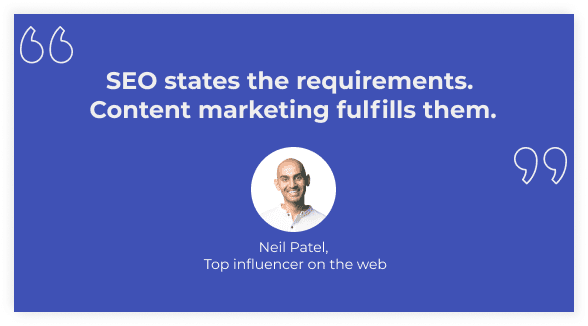When I think about content, I focus on creating pieces that connect the dots and also provide enough simple steps to achieve a specific goal. Stop overthinking and procrastinating on topics to create content about, build a profile of your target audience, and incorporate every keyword (s) that matters. Keep in mind that your target audience is only part of the puzzle but has to be the fundamentals of why you are creating content.
Remember to focus on the ball, SEO. If your content is not ranking, you are not incorporating these processes into your content creation.

Now, you’ll think this is easy, but there are millions of websites that do not follow this practice and turn to create content that doesn’t relate or connect with their offerings. Writing without providing answers or solutions is like flying to the unknown, don’t be that!
- Define and Understand Your Target Audience
- Define Your Content Creation Goals
- Identify Key Topics & Pain Points
- Choose the Right Content Format
- Craft Engaging Headlines and Hooks
- Develop High-Quality Content
- Personalize and Segment Content
- Promote Your Content
- Engage and Interact with Your Audience
- Measure and Analyze Performance
1. Understand Your Target Audience
Make this your focal point, and narrow down the types of personas you think fit the audience profile.
Understanding your target audience is essential for creating content that resonates and drives engagement. This involves researching and analyzing your audience’s demographics, interests, behaviors, and pain points. By knowing who your audience is, you can tailor your content to meet their specific needs and preferences, making it more relevant and compelling.
This targeted approach enhances your content's effectiveness and fosters stronger connections with your audience. Understanding your audience helps you choose the right formats, channels, and messaging strategies, ensuring your content reaches and impacts the right people.
Plain simple, a deep understanding of your target audience is the foundation for any successful content strategy, guiding the creation of content that is both meaningful and effective.
Research
- Demographics: Age, gender, income, education, occupation.
- Psychographics: Interests, hobbies, values, lifestyle, attitudes.
- Behavioral Data: Buying habits, brand interactions, content preferences.
Create Personas
- Develop detailed profiles of your ideal customers. Include demographic details, challenges they face, their goals, and how your product or service can help them.
2. Define Your Content Creation Goals
Each goal will shape your content in different ways. For instance, if your goal is to boost brand awareness, your content might focus on storytelling and sharing the brand's values and mission.
If your goal is to generate leads, your content might be more instructional and geared towards solving specific problems your target audience faces, potentially leading them to a call to action.
Setting clear, measurable goals is essential for tracking progress and assessing the effectiveness of your content strategy.
Metrics like increasing website traffic by 30%, achieving a certain number of social media shares, or generating monthly customer leads can provide tangible benchmarks to gauge success and make informed adjustments.
Understanding your audience is another critical component in defining your content creation goals. Knowing who you are writing content for helps tailor your messages to meet their needs and preferences, ensuring relevance and engagement.
Researching your audience’s demographics, interests, challenges, and content consumption habits is vital for this alignment. Additionally, integrating your content creation goals with your overall business objectives ensures consistency and coherence in your marketing efforts.
Your content should complement and enhance your broader marketing and business strategies, maintaining a unified brand voice and message across all channels. This alignment helps reinforce your brand identity and values while ensuring that every piece of content contributes to driving your business forward.
By clearly defining your content creation goals and aligning them with your business objectives, you create a roadmap that guides your content efforts toward meaningful, impactful results.
- What do you want to achieve? Increased engagement, leads, sales, and brand awareness?
- What actions do you want your audience to take? Share content, sign up for newsletters, make a purchase?
3. Identify Key Topics and Pain Points
Identifying key topics and pain points for content creation involves understanding the target audience's needs, challenges, and interests.
Key topics often include industry trends, common questions, and relevant solutions that resonate with the audience. Pain points are specific issues or problems that the target audience frequently encounters, such as inefficiencies, lack of knowledge, or frustrations with current solutions.
Effective content addresses these pain points by providing valuable insights, practical tips, and actionable solutions, establishing trust and authority while driving engagement and conversions. Conducting thorough research, engaging with the audience through surveys and feedback, and analyzing competitors can help pinpoint these critical areas.
- Keyword Research: Use tools like Google Keyword Planner, SEMrush, or Ahrefs to find popular search terms relevant to your audience.
- Competitor Analysis: Look at what your competitors are publishing and what performs well.
- Audience Feedback: Surveys, social media comments, and customer reviews to understand their challenges and interests.
4. Choose the Right Content Formats
Choosing the right content formats is crucial for effectively engaging your target audience and meeting your business objectives.
Consider the preferences of your audience, the nature of the message, and the platforms where your content will be shared. For example; videos and infographics are highly engaging and suitable for social media, while detailed articles and whitepapers work well for in-depth analysis and SEO.
With so many outlets for content today, podcasts cater to on-the-go listeners, and interactive content like quizzes and webinars can boost participation and feedback. Aligning content format with audience needs and platform strengths maximizes impact and achieves desired outcomes.
- Blog Posts: In-depth articles, how-tos, listicles.
- Videos: Tutorials, testimonials, product demos.
- Infographics: Visual representations of data or processes.
- Podcasts: Interviews, and discussions on industry topics.
- Social Media Posts: Short, engaging updates, images, and videos.
5. Craft Engaging Headlines and Hooks
Crafting engaging headlines and hooks involves capturing the essence of your content while piquing the audience's curiosity to make them take action.
Use powerful, action-oriented words to create a sense of urgency or excitement, ensuring the headline is concise yet descriptive. Incorporate questions, numbers, or intriguing phrases that promise a benefit or a surprising revelation.
Personalize the hook to resonate with the target audience, tapping into their emotions, needs, or desires. A compelling headline should be clear, and capable of drawing readers in, making them eager to discover more and digest.
- Clear and Compelling: Address a pain point or offer a solution to a specific or broad issue.
- Use Power Words: Words that evoke emotion or curiosity (Ex., “advanced” “ultimate,” “top” “proven,” “secret”).
- Include Numbers: Lists and data attract attention (ex. “10 Tips to Improve…”). Try it! Using a Blog Topic Generator.
6. Develop High-Quality Content
Developing high-quality content involves creating engaging, informative, and valuable material that resonates with the target audience.
This requires thorough research to ensure accuracy, originality to stand out from the competition, and a deep understanding of the audience’s needs and preferences. High-quality content is well-structured, visually appealing, and optimized for search engines, making it easily discoverable.
Your content should be interactive and actionable, encouraging audience interaction and providing clear, practical takeaways. Consistency in tone and style, along with regular updates, helps maintain relevance and build trust with the audience.
- Value-Driven: Offer actionable insights and information that solve problems or add value.
- Storytelling: Use narratives to make content relatable and memorable.
- Visuals: Use images, videos, and infographics to break up text and illustrate points.
- SEO Optimization: Use relevant keywords naturally, optimize meta tags, and ensure content is structured for readability.
7. Personalize and Segment Content
Personalizing and segmenting content involves tailoring information to meet the specific needs, preferences, and behaviors of different audience segments.
By leveraging data analytics and customer insights, businesses can create targeted content that resonates more deeply with each group, enhancing engagement and satisfaction. This approach will not only increase the relevance of the content but also improve its effectiveness in driving desired actions, such as conversions or loyalty.
Personalization can range from simple demographic-based adjustments to sophisticated, real-time content modifications, while segmentation allows for the grouping of audiences based on shared characteristics, ensuring each segment receives the most pertinent and compelling information.
Here are a few types of popular segmentation;
- Email Marketing: Tailor content based on subscriber segments.
- Dynamic Website Content: Show different content based on visitor behavior or profile.
- Retargeting Ads: Use personalized ads to re-engage users who have interacted with your content.
8. Promote Your Content
With every content created, be prepared to develop a unique promotion strategy that targets your audience using social media, email marketing, and other channels. Social media platforms can be a great outlet for creating content that your audience likes, engages with, and shares.
- Social Media: Share across platforms where your audience is active.
- Email Campaigns: Send newsletters or dedicated emails with your content.
- Collaborations: Partner with influencers or other brands to expand reach.
- Paid Advertising: Use targeted ads to reach a broader audience.
9. Engage and Interact with Your Audience
Engaging and interacting with your audience is essential for building a loyal community and fostering meaningful connections.
This involves actively listening to their feedback, responding to comments and messages promptly, and creating content that resonates with their interests and needs.
Use interactive elements such as polls, Q&A sessions, and live events to encourage participation and make your audience feel valued and heard. Personalizing your communication and showing genuine appreciation for their support can enhance their overall experience, leading to increased trust and long-term engagement.
- Comments and Feedback: Respond to comments and engage in discussions.
- Community Building: Create groups or forums for your audience to interact.
- Live Sessions: Host webinars, and live Q&A sessions to directly interact.
10. Measure and Analyze Content Performance
Measuring and analyzing content performance involves a multifaceted approach aimed at understanding the effectiveness of various content pieces across different platforms and channels.
This process encompasses tracking key performance indicators (KPIs) such as engagement metrics, conversion rates, traffic sources, and audience demographics.
Using analytics tools and platforms, content creators can gain insights into what content resonates most with their target audience, enabling them to refine their strategies, optimize content for better performance, and allocate resources more effectively.
By continuously monitoring and analyzing content performance, organizations can make data-driven decisions to enhance their content marketing efforts and achieve their business objectives.
- Analytics Tools: Use Google Analytics, social media insights, and email marketing stats.
- KPIs: Track metrics like traffic, engagement, conversion rates, and shares.
- Adjust and Improve: Use data to refine your strategy, and experiment with different formats, and topics.
Conclusion
Creating enticing target content requires a deep understanding of your audience, clear goals, and a commitment to delivering value through well-crafted and strategically distributed content. With that in mind, regularly analyze performance and improve your content strategy.


